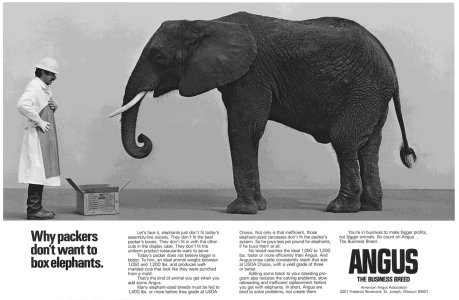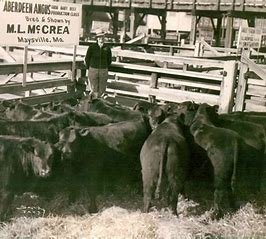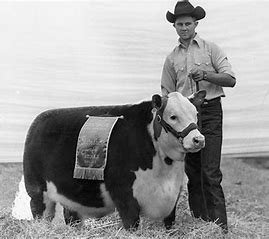simme
Old Dumb Guy
In a thread a few weeks ago, I referred to the 30 year old elephant ad put out by the AAA. Making fun of continental breeds, mostly simmental I think. Cows too big to be efficient, eat too much, carcass too big, etc. Looks like the tide has turned. I noticed in the latest issue of Sim-Talk (free Simmental publication for commercial producers - go to simmental.org to sign up) a new Simmental ad showing Meat Animal Research Center data that shows that Angus cows now have the heaviest mature weight of the 16 beef breeds studied: 20 pounds heavier than Charolais, 39 pounds heavier than Hereford and 74 pounds heavier than Simmental. Looks like maybe there is a new elephant in the room. I know some here have mentioned having angus cows that are 1800 pounds and even 2000 pounds. Who needs that size cows? Just seems too big to me. My simmie cows are about 1400 pounds at maturity. Plenty big for me and maybe too big for many environments. Study looked at over 100,000 weight records. Many years ago, some of the simmental cattle had a reputation for being hard doing, hard keeping. Extra input to maintain body condition. I remember about 10 years ago an article in the simmental monthly member publication that reported that angus had become harder keeping than simmental.
Has this happened due to chasing carcass traits? How did the little angus of years ago become the biggest cow of 16 major breeds? Good or bad? From the MARC website: Adjusted for sire sampling, Angus was heaviest at maturity of the breeds compared. Deviations from Angus ranged from -8.9 kg (Charolais) to -136.7 kg (Braunvieh). Ordered by decreasing MWT, the breeds ranked Angus, Charolais, Hereford, Brahman, Salers, Santa Gertrudis, Simmental, Maine Anjou, Limousin, Red Angus, Brangus, Chiangus, Shorthorn, Gelbvieh, Beefmaster, and Braunvieh. These breed effects for MWT can inform breeding programs where cow size is considered a key component of the overall profitability.
Here are the old elephant ad and and the new ad as a PDF.

Has this happened due to chasing carcass traits? How did the little angus of years ago become the biggest cow of 16 major breeds? Good or bad? From the MARC website: Adjusted for sire sampling, Angus was heaviest at maturity of the breeds compared. Deviations from Angus ranged from -8.9 kg (Charolais) to -136.7 kg (Braunvieh). Ordered by decreasing MWT, the breeds ranked Angus, Charolais, Hereford, Brahman, Salers, Santa Gertrudis, Simmental, Maine Anjou, Limousin, Red Angus, Brangus, Chiangus, Shorthorn, Gelbvieh, Beefmaster, and Braunvieh. These breed effects for MWT can inform breeding programs where cow size is considered a key component of the overall profitability.
Here are the old elephant ad and and the new ad as a PDF.






